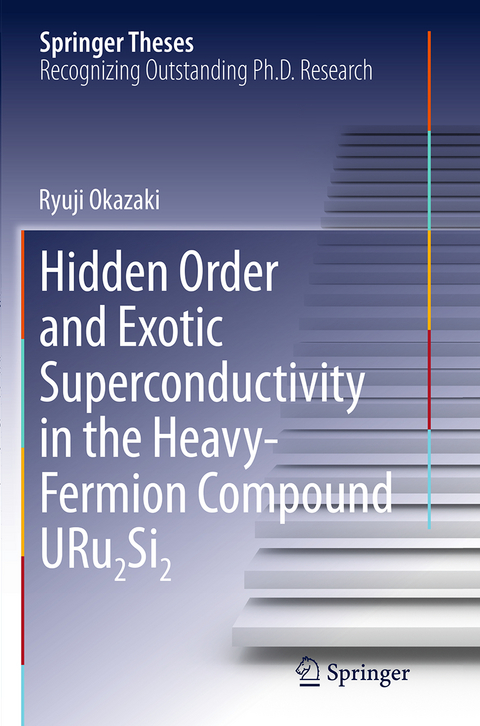
Hidden Order and Exotic Superconductivity in the Heavy-Fermion Compound URu2Si2
Seiten
2016
|
Softcover reprint of the original 1st ed. 2013
Springer Verlag, Japan
978-4-431-56359-4 (ISBN)
Springer Verlag, Japan
978-4-431-56359-4 (ISBN)
In this thesis, the author investigates hidden-order phase transition at T0 = 17.5 K in the heavy-fermion URu2Si2. The translationally invariant phase with broken rotational symmetry is interpreted as meaning that the hidden-order phase is an electronic “nematic” phase.
In this thesis, the author investigates hidden-order phase transition at T0 = 17.5 K in the heavy-fermion URu2Si2. The four-fold rotational symmetry breaking in the hidden order phase, which imposes a strong constraint on the theoretical model, is observed through the magnetic torque measurement. The translationally invariant phase with broken rotational symmetry is interpreted as meaning that the hidden-order phase is an electronic “nematic” phase. The observation of such nematicity in URu2Si2 indicates a ubiquitous nature among the strongly correlated electron systems.
The author also studies the superconducting state of URu2Si2 below Tc = 1.4 K, which coexists with the hidden-order phase. A peculiar vortex penetration in the superconducting state is found, which may be related to the rotational symmetry breaking in the hidden-order phase. The author also identifies a vortex lattice melting transition. This transport study provides essential clues to the underlying issue of quasiparticle dynamics as to whether a quasiparticle Bloch state is realized in the periodic vortex lattice.
In this thesis, the author investigates hidden-order phase transition at T0 = 17.5 K in the heavy-fermion URu2Si2. The four-fold rotational symmetry breaking in the hidden order phase, which imposes a strong constraint on the theoretical model, is observed through the magnetic torque measurement. The translationally invariant phase with broken rotational symmetry is interpreted as meaning that the hidden-order phase is an electronic “nematic” phase. The observation of such nematicity in URu2Si2 indicates a ubiquitous nature among the strongly correlated electron systems.
The author also studies the superconducting state of URu2Si2 below Tc = 1.4 K, which coexists with the hidden-order phase. A peculiar vortex penetration in the superconducting state is found, which may be related to the rotational symmetry breaking in the hidden-order phase. The author also identifies a vortex lattice melting transition. This transport study provides essential clues to the underlying issue of quasiparticle dynamics as to whether a quasiparticle Bloch state is realized in the periodic vortex lattice.
Dr.Ryuji Okazaki Department of Physics, Nagoya University, Chikusa, Nagoya 464-8602, Japan.
Introduction.- Heavy-Fermion Superconductor URu2Si2.- Magnetic torque Study on the Hidden-Order Phase.- Lower Critical Field Study on the Superconducting Phase.- Vortex Lattice Melting Transition.- Conclusion.
| Erscheinungsdatum | 11.09.2016 |
|---|---|
| Reihe/Serie | Springer Theses |
| Zusatzinfo | 71 Illustrations, color; XIII, 102 p. 71 illus. in color. |
| Verlagsort | Tokyo |
| Sprache | englisch |
| Maße | 155 x 235 mm |
| Themenwelt | Naturwissenschaften ► Physik / Astronomie ► Festkörperphysik |
| Naturwissenschaften ► Physik / Astronomie ► Thermodynamik | |
| Technik ► Elektrotechnik / Energietechnik | |
| Technik ► Maschinenbau | |
| Schlagworte | Electronic Nematicity • Heavy-fermion superconductors • Heavy-fermion URu2Si2 • Hidden Order in Correlated Electron Systems • Quasiparticle Bloch State • Superconducting State of URu2Si2 • URu2Si2 • Vortex Lattice Melting |
| ISBN-10 | 4-431-56359-8 / 4431563598 |
| ISBN-13 | 978-4-431-56359-4 / 9784431563594 |
| Zustand | Neuware |
| Haben Sie eine Frage zum Produkt? |
Mehr entdecken
aus dem Bereich
aus dem Bereich


